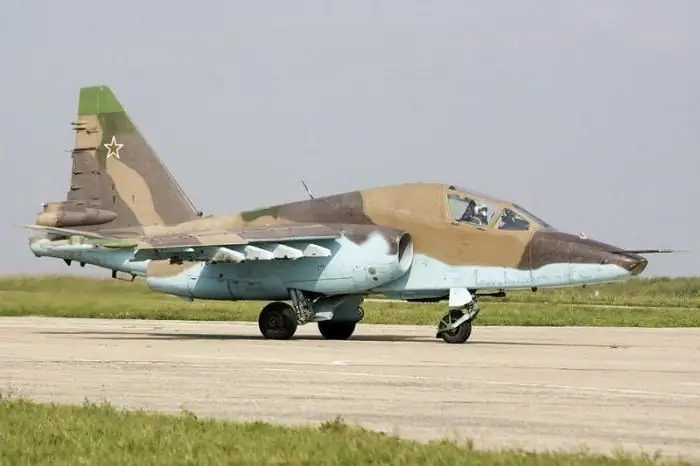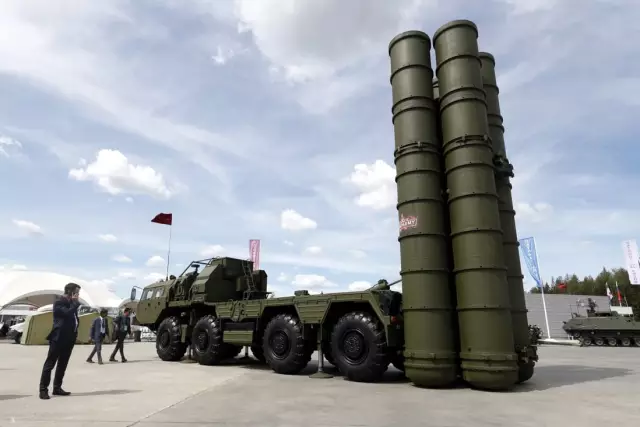2026 Author: Howard Calhoun | [email protected]. Last modified: 2025-01-24 13:10:31
Light anti-tank weapons became very popular during the Second World War. The Germans achieved particular success in this field, with their "faustpatrons", which knocked out even heavy tanks. Trophy faustpatrons were also used by Soviet soldiers with great pleasure, since the USSR did not have such weapons in World War II.
The emergence of Soviet RPGs
Based on German developments after the war, the RPG-2, the first Soviet anti-tank grenade launcher, was created. And already on its basis in 1961 the legendary RPG-7V was created. The decoding of the name is simple.
It repeats the RPG-2 marking with minor changes. "Hand-held anti-tank grenade launcher. Type 7. Type B shot." The main difference between the RPG-7 and the previous modification was the presence of an active-jet engine along with a powder charge, which made it possible to increase the range and accuracy while reducing recoil. The RPG-7V is the most massive hand-held anti-tank grenade launcher in the world.

Already the first use of a grenade launcher in Vietnam showed its high efficiency. Most of the American armored vehicles of that time, including heavy tanks, could not oppose grenade launchers. The Israelis also began to suffer heavy losses from RPGs during conflicts with the Arabs. Soviet weapons pierced homogeneous armor of any thickness, and only the appearance of multilayer armor became a salvation for Western tanks.
Grenade launcher design
The grenade launcher includes a barrel with an open sight, a trigger mechanism and a fuse and a firing mechanism. On later modifications, an optical sight is also installed. The barrel, which houses the tail of the shot, looks like a smooth tube with an expansion chamber in the middle. The branch pipe is connected to the barrel with a thread. In front of the branch pipe there is a nozzle, which is two converging cones. At the rear of the nozzle there is a bell with a safety plate to prevent contaminants from entering the breech breech. On the barrel in front there is a cutout for fixing a grenade, and a folding sight and front sight are located on top.

Below the barrel is a firing mechanism located inside the pistol grip. Behind the main handle there is an additional one designed for a more comfortable holding of the weapon when firing. To the left of the barrel is a bracket for mounting an optical sight. On the right are swivels that allow you to attach a belt. attached to the stemtwo symmetrical birch wood pads that protect the shooter's hands from burns. The resource of the barrel is 250-300 shots.
Sight
In the modification of the RPG-7V grenade launcher, they began to equip it with an optical sight with a 2.7x magnification. The sight consists of three scales - the main aiming scale, the lateral correction scale and the rangefinder scale, designed for a height of 2.7 meters, that is, the height of the tank's silhouette. The sight scale is marked with divisions with a price of 100 m. The mechanical sight in this case remains on the weapon, but is auxiliary. Characteristically, both scopes have a mechanical temperature correction setting.
Calculation and use
The standard calculation of a grenade launcher is two people. But the second is necessary only as a carrier of ammunition for prolonged firing. The shot itself is made by one person without outside help, due to the small weight of the weapon and the absence of serious recoil.

In most local conflicts, RPGs are used exactly according to this principle, as a convenient means for eliminating single armored targets, not interfering with a quick retreat. The crew of two people is convenient when destroying transport columns, allowing you to quickly destroy the outer vehicles and lock the column. In a frontal confrontation with tanks, the grenade launcher has no chance to live long without changing position.
Firing a shot
To do this, you need to cock the trigger, then remove the weapon from the fuse. After that, the shot is fired by pressing the triggerhook. In this case, the trigger rotates up and strikes the striker. The striker jerks up and breaks the primer at the bottom of the rocket engine. At the same time, a beam of fire from the primer ignites the gunpowder in the charging chamber. Powder gases, expanding, push the rocket. As soon as the rocket begins to move, the capsule on the rocket's pyro-retarder is pierced, and the retarder composition begins to burn.
In flight
After leaving the barrel, due to inertia and air flow, the stabilizing planes of the rocket are revealed.

When the rocket flies about 20 meters, the flame of the moderator gets to the jet engine checkers, and the main jet engine starts to work. It works for about half a second and manages to accelerate the rocket to 300 m/s from the original 120 m/s.
In flight, the grenade rotates around its longitudinal axis due to the pressure of the air flow on the stabilizing blades. The rotation speed is up to 30-40 revolutions per second. Rotation in this case performs the same functions as in rifled weapons. Even though an RPG projectile rotates very slowly compared to a bullet making several thousand revolutions per second, it is this rotation that gives the grenade the ability to maintain a trajectory. This is especially true given the positioning of the RPG as a weapon focused on cheap mass production and the inevitable in this case, large, compared to Western models, manufacturing tolerances.
Explosion of warhead
At a distance of 2.5 to 18 meters from the muzzle inthe rocket is cocked by an electric detonator. When in contact with an obstacle, the drummer, under the influence of inertia, hits the detonator. A detonator explodes and a grenade explodes. If during the flight the grenade does not stumble upon the target, then after 4-6 seconds it will self-destruct.
Modifications
Many years of operation of the grenade launcher in a variety of conditions did not actually reveal any significant shortcomings in the performance characteristics of the RPG-7V. Therefore, the main directions in which it was modernized were the modernization of sights and the improvement of the armor penetration of ammunition. An exception was the landing modification of the RPG-7V. The performance characteristics of weapons for the Airborne Forces have been changed due to restrictions on the length of the grenade launcher in the stowed position. The weapon should not stick out from behind the paratrooper's shoulder and interfere with the parachute. Therefore, in the RPG-7D modification, the launch tube is connected to the branch pipe dryly due to the protrusions on the branch pipe and the grooves on the pipe. This allows you to transport the grenade launcher in the folded position. The fuse has also been changed, which does not allow a shot to be fired without a complete connection of the pipe and nozzle. Among other modifications, the 7N and 7DN variants with a night sight can be noted. Option 7V1 is equipped with a PGO-7V3 sight. The last Russian version of the 2001 RPG-7D3 differs only in small changes in the old sight. There are even RPG-7s manufactured by the US Airtronic USA Mk.777, which is an indicator of the quality of this weapon.

Anti-tank ammunition and armor penetration
However, like any grenade launcher, the differences in the performance characteristics of the RPG-7V and latermodifications lie to a greater extent not in the design of the weapon, which is essentially a pipe with a striker, but in ammunition. The armor penetration of different shots varies greatly. Most of the rounds for the RPG-7 are HEAT rounds, but there are also fragmentation modifications for engaging infantry.

The weight of the base charge of PG-7V is 2.6 kg. The maximum armor penetration of the shaped charge is 330 mm. The next modification was the PG-7VM, which, while maintaining the basic characteristics, received better accuracy and resistance to side wind. This model also has a more stable fuse.
Improved armor penetration to 400 mm was already received by the PG-7VS variant. This shot has a more powerful charge and reduced HEAT spray.
To defeat new tanks with composite armor, the PG-7VL Luch ammunition was created. It is distinguished by armor penetration up to 500 mm of homogeneous armor and a new high-reliability fuse.
The most advanced cumulative munition at the moment is the PG-7VR "Summary" of 1988. It has an easily recognizable complex shape due to the tandem warhead. The first weaker charge with a caliber of 64 mm is designed to destroy dynamic protection or an anti-cumulative screen. The second main charge with a caliber of 105 mm already penetrates the main armor of the target. This shot in the stowed position is transported disconnected due to its great length. Its warhead is attached to the jet engine using a threaded connection, which allowstake it off when transporting. The jet engine and propellant charge of this shot differ little from the PG-7VL variant, with the exception of special springs that help open the stabilizer planes. The weight of the "Resume" is almost twice as high as the previous versions and is 4.5 kg. But, at the same time, the ammunition allows you to penetrate armor equivalent to 600 mm homogeneous and plus dynamic protection. These figures make the cheap Soviet RPG-7 dangerous even for modern Western tanks, at least when firing at the stern.
Frag munitions
Although being an anti-tank weapon, the RPG-7 is designed primarily to destroy armored vehicles, its light weight and simplicity make it a versatile weapon. Therefore, ammunition is also in demand for the destruction of manpower on the ground or in light shelters. Shot OG-7V "Splinter" is a fragmentation ammunition without a jet engine. When exploded, it creates about a thousand fragments that hit targets in an area of 150 square meters. m. It can also be used against light shelters and unarmored vehicles.
Thermobaric munitions
More dangerous and perfect ammunition is TBG-7V "Tanin". It has a thermobaric warhead that creates a so-called "volumetric explosion". The blast wave penetrates the premises even when the ammunition is detonated at a distance of 2 meters from the window or loophole. The total diameter of the projectile impact zone is up to 20 meters, which is comparable to a standard 120 mm artillery ammunition. The maximum volume of the room in which the volumetriceffectively strikes manpower equal to 300 cubic meters. m. But in addition to the explosion, fragments are also a serious damaging factor, which, due to the use of a thermobaric mixture, have an increased initial velocity. This shot also destroys light vehicles. When a warhead hits armor up to 20 mm thick, a hole is burned in it, and the cumulative jet hits the crew. With such a hit, the pressure inside the vehicle breaks even closed landing hatches.
Use against tanks
At the time of the launch of the RPG-7V performance characteristics series, they allowed it to hit any modern battle tank. The effectiveness of the grenade launcher has been repeatedly proven in Vietnam and during the Arab-Israeli wars. It can be called the best anti-tank defense of the second half of the 20th century in terms of price-quality ratio.
However, the adoption in the 1980s of a new generation of Western tanks with multilayer armor and the use of dynamic protection led to the need to improve the grenade launcher. This is what led to the creation of the "Resume" variant with tandem ammunition. It should be noted that in most major conflicts since the collapse of the USSR, there are very controversial examples of the use of RPG-7 against modern tanks. There are both cases of hitting a car with one shot, and cases of receiving more than 10 hits from an RPG without armor. From this it can be deduced that in each individual case, many factors must be taken into account. First of all, the place of impact. The frontal armor is many times more stable than the stern armor. Then the presence of dynamic protection,anti-cumulative screens and foreign objects on the armor. Finally, the speed and direction of movement of the armored vehicle and the angle of attack of the cumulative jet.

Thus, the RPG-7, along with the Kalashnikov assault rifle, can be called one of the best examples of Soviet infantry weapons, recognized throughout the world and having its own image and popularity.
Recommended:
What is performance: concept, criteria and performance indicators

To build a system of staff motivation and to improve management, it is necessary to understand how efficiently employees and managers work. This makes the concept of efficiency extremely relevant in management. Therefore, you need to know what performance is, what are its criteria and evaluation methods
ZRK S-125 "Neva": development, performance characteristics, modifications

S-125 "Neva" - a short-range anti-aircraft missile system manufactured in the USSR. This article will consider the history of its creation and the main performance characteristics
Guided missile "Vikhr-1": performance characteristics. OJSC "Concern "Kalashnikov""

Tanks, having barely appeared for the first time on the battlefield, had a tremendous impact on the entire military thought of that time. Anti-tank rifles, special ammunition appeared instantly, regimental artillery experienced a rebirth
Synthetic gasoline: description, characteristics, performance, production methods

Science and progress allow you to create things that have never been seen before, which many could not even think of. Take, for example, such a relatively new development as synthetic gasoline. Many people know that this fuel is obtained by distillation from oil. But it can also be synthesized from coal, wood, natural gas. The production of synthetic gasoline, although it cannot fully replace the conventional route of production, still deserves to be studied
Anti-aircraft missile system. Anti-aircraft missile system "Igla". Anti-aircraft missile system "Osa"

The need to create specialized anti-aircraft missile systems was ripe during the Second World War, but scientists and gunsmiths from different countries began to approach the issue in detail only in the 50s. The fact is that until then there simply were no means of controlling interceptor missiles

